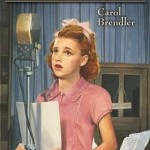Welcome to Craft Talk Tuesday! Once or twice a month, The Writing Barn, will be posting in-depth essays on craft issues on Tuesday’s–waalah–that’s how we came up with the CTT title. On opposite weeks from CTT, we will be hosting What My Last Book Taught Me Wednesday’s, where authors will be sharing personal and professional insights around the creation of their most recent projects.
We are thrilled to launch this new series with Carol Brendler’s essay on the objective correlative. Without further adieu…
Don’t Do Emotion, Huh? Try Faking It with an Objective Correlative
 If you come from a family where openly showing emotion makes others uncomfortable, you might struggle with showing emotion in your fiction. I had that problem. When expressing emotion in our real lives has been equated with, oh, say, walking through a museum with one’s fly open or eating Twinkies in church, evoking emotion in our work can be daunting, if not downright inscrutable. So what’s a writer to do?
If you come from a family where openly showing emotion makes others uncomfortable, you might struggle with showing emotion in your fiction. I had that problem. When expressing emotion in our real lives has been equated with, oh, say, walking through a museum with one’s fly open or eating Twinkies in church, evoking emotion in our work can be daunting, if not downright inscrutable. So what’s a writer to do?
Here are two typical methods writers use to make emotion happen in their fiction:
- They just name it. They say outright that their character feels sad, mad, glad, or whatever (I call this the lame approach.)
- They use actions and gestures, showing emotions by having their characters clench their jaws, smile, cry, tremble. (The problem with this is, if we write that a character felt, say, pleased, that word slips right past the reader without making an impact. You usually want the reader to stop and feel the emotion alongside your character.)
There’s a third way, and it’s a better way. It’s called the objective correlative, aka the OC. The OC is a way of evoking emotion by using other things that your character sees, touches, hears, etc. in the scene in order to show their emotional state. Here’s a definition:
“a set of objects, a situation, a chain of events which shall be the formula for that particular emotion; such that when the external facts, which must terminate in a sensory experience, are given, the emotion is immediately evoked.” T. S. Eliot in “Hamlet and His Problems” (1919)
Man, that’s dense. Let’s break it down. First, try this easy exercise. Describe what your point-of-view character’s state of mind would be if he were to:
⁃ smell his missing father’s cologne
⁃ look out of a frosty window on a bleak, snowy day
⁃ run his fingers over a velvet cloak in the dark
⁃ hear the opening notes of the Brady Bunch theme song
⁃ bite into a jelly bean he thought was going to be cherry but it turns out to be chili pepper-flavored
Any of those descriptions/situations could evoke an emotion. Here’s what they brought out in my character: Sadness, Wistfulness, Pleasure, Curiosity, Repugnance.
Now turn to your work in progress, to a scene that needs an emotional punch. Identify the emotion needing to be evoked. Next, find something in the scene (you may already have placed it there subconsciously–if not, add it) that you can correlate to the emotion.
Imaginary example: Say your character, a finicky princess, is feeling pleased. A lesser writer than you might write “She felt very pleased about the luxurious treatment the servants gave her at the castle.” But why write something so lame when you can have your character actually feel the velvet duvet, smell the fresh flowers by her bedside, and enjoy the faint strains of harp music from the chamber below, evoking the emotion without ever once use the word “pleased”?
How I find the OC in my scenes is to begin with the emotion my character is feeling, then show (not tell) the reader in an oblique but (paradoxically) more effective way by correlating that feeling to something tangible in the scene.
Here are a couple of examples from my forthcoming middle grade novel, Radio Girl (Holiday House, September, 2013):
The scene is the tiny bathroom in the Maloney apartment. While her father shaves, main character, Cece Maloney, tries unsuccessfully to ask him to let her work at his radio station. After he finishes shaving and leaves the bathroom, she stays behind:
to ask him to let her work at his radio station. After he finishes shaving and leaves the bathroom, she stays behind:
Pop made for the kitchen while I stayed seated on the toilet lid, the work permit rolled up in my hand. I watched the water in the sink swirl and swirl and finally disappear down the drain, leaving Pop’s reddish-blond hairs and bits of shaving cream behind.
“I don’t think so, baby,” Pop had said. I don’t think so. Just like that, my dreams of a radio career went down the drain, too.
I could’ve just written “She was so disappointed.” Blah. That’s almost meaningless and, let’s face it, too obvious.
But wait, there’s more! Much later, Cece is on the ferry, sneaking off to New York by herself, having just left the stifling heat back home  in Newark:
in Newark:
I leaned against a damp railing on the Hoboken ferry, bound for the 39th Street dock. The mist on the river cooled my face and arms. Waves on the Hudson caught the sun and glimmered like the sequins on a radio star’s evening gown. I’d never been across the Hudson by myself before, and the freedom of it made me feel like one snappy piece of work.
Okay, so I did use the more direct word “freedom” to describe her emotion, but I think describing the feel of the mist and the look of the waves does way more to show the exuberance Cece feels. To quote Tim Wynne Jones quoting Emily Dickinson in his Vermont College of Fine Arts lecture “Smoke and Mirrors” (where I first learned of the OC), “tell it slant.”
You’ll know when an author has not yet embraced the OC by how often their characters grin and cringe and sigh. There’s nothing wrong with those actions, but sometimes they’re overused. Also, you’ll sometimes come across a new author struggling for a fresh way to show his character’s emotion through action and ending up with a convoluted description that only calls attention to the writer’s plight, as in:
- “Her mouth turned up at the corners and her lips opened, showing her teeth.” (aka, she smiled.)
- “He exhaled audibly in a frustrated way.” (In other words, he sighed.)
It happens because the author’s trying to avoid too much smiling or sighing in her story. It could be because she was like me once, and thinks she can’t “do” emotion. My advice, get hooked on the OC. It’s a strong tool for evoking emotion.
It won’t, however, stop you from eating Twinkies in church. And as far as your zipper goes, you’re on your own.
——————————————
More on the objective correlative:
Author Cori McCarthy‘s fun-to-read OC essay: http://kidlit.com/2011/07/06/vcfa-guest-post-props-for-emotion-the-objective-correlative-unveiled/
This essay by Scott W. Smith comes at the OC from a dramatic point of view: http://screenwritingfromiowa.wordpress.com/2011/02/24/objective-correlative-tip-48/
OC Trivia:
- Term first coined prior to 1850 by Washington Allston , but later given its more literary meaning by T.S. Eliot in an essay about why Hamlet is a failed play.
- Emily Dickinson’s “Tell All the Truth” http://www.poemhunter.com/poem/tell-all-the-truth/ (but tell it slant) is one of over 1,700 poems she wrote.
Carol Brendler is the author of WINNIE FINN, WORM FARMER (FSG, 2009) a picture book illustrated by Ard Hoyt. Her middle-grade novel, RADIO GIRL, (Holiday House) will be released on September 5, 2013. Another picture book, NOT VERY SCARY, illustrated by Greg Pizzoli, is on the way from FSG in July, 2014. Carol holds a Master’s Degree in Writing for Children and Young Adults from the Vermont College of Fine Arts (2008). She grew up in a small town in the crook of Michigan’s “thumb.” Now she writes, dabbles at playing ukulele, kills houseplants, and knits in the suburbs of Chicago. Visit Carol’s blebsite (blog+website): www.carolbrendler.com
DON’T MISS THE CHANCE to Bid on a 5 day/4 night Writing Retreat Stay at The Writing Barn, in sunny Austin, Texas over at the Hunger Mountain e-bay auction. We’ll even throw in some Shinerbock beer for the winning writers. And check out all the agent and author critiques up for auction, here. Bid now! Bid often!

Comments are closed.